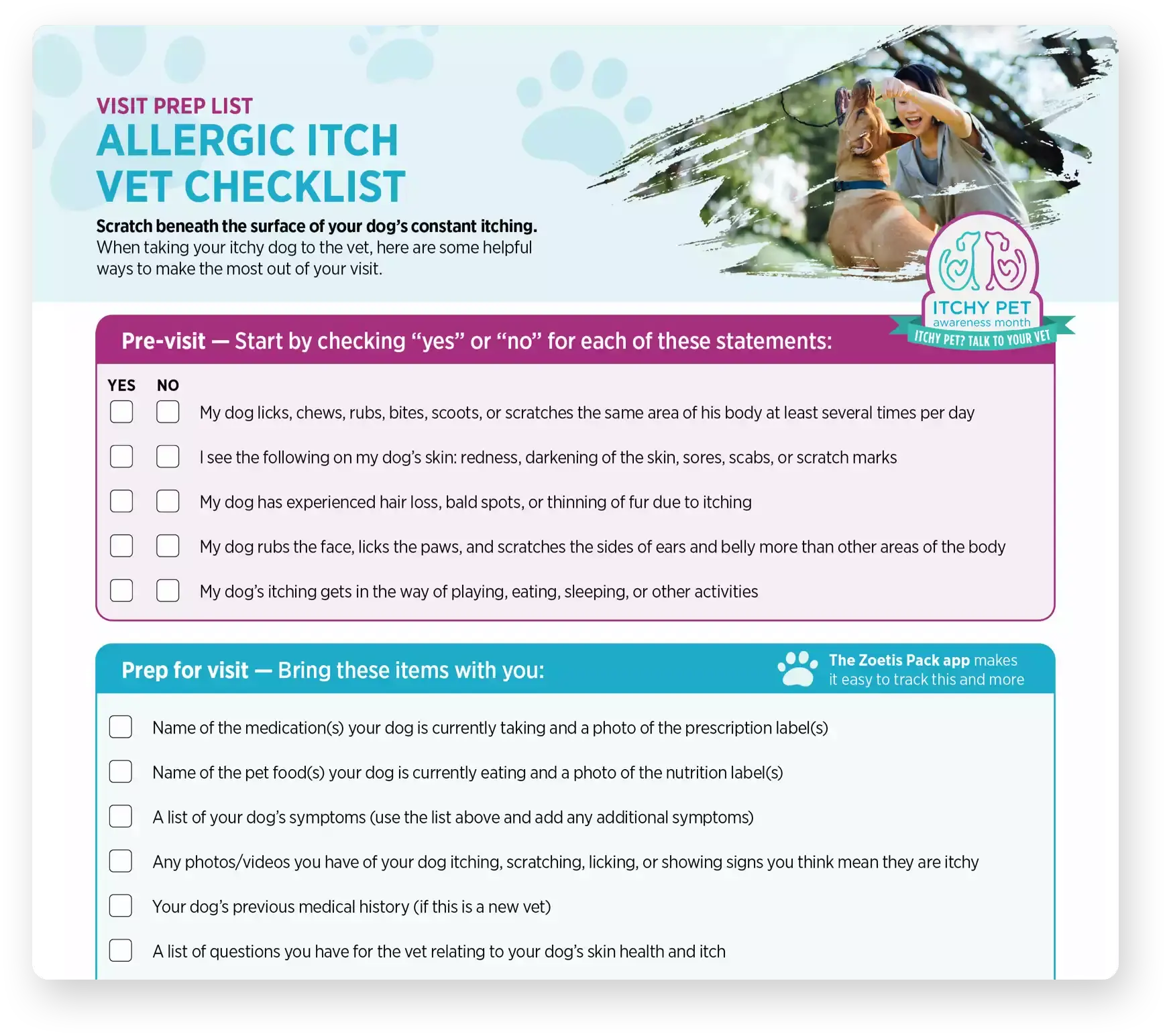Treat allergic itch on a deeper level
So over over the counter? Don’t DIY. Enough of the shampoos that bubble up to a bigger problem, the supplements that simply don’t work, and the antihistamines that can prevent the root of the problem from getting addressed.

What you should know about common treatments
You may have tried other treatments to relieve your dog’s allergic itch. Getting your dog the right treatment early on can help quickly relieve the signs of itch and avoid the costs associated with treatments that just don’t do the trick.
- Can relieve allergies in humans but are often not effective at reducing allergic itch in dogs4,5
- Can put your dog at risk for progression of allergic itch and secondary skin infection because they don’t treat the underlying cause and the itch continues
- Offer little or no benefit in treating flare-ups in the majority of dogs6
- May offer relief but may not be a good option if your dog requires long-term treatment. Up to 50% of dog owners report side effects with steroids7
- Can cause side effects such as excessive drinking and urinating, increased appetite, and behavior changes (such as increased anxiety) even when used short term8,9
- Oatmeal baths, lotions, or over-the-counter topical medicines may provide some temporary relief but don’t get to the underlying cause of allergic itch
- Grain-free diets are unlikely to help most dogs with allergic itch. Only a small proportion (10%-25%) of dogs with allergic skin disease have a food allergy, and protein sources like beef, chicken, and dairy products are the most common food allergies in dogs10,11
- Supplements, such as fish oil or probiotics, may support overall skin health, but they are not proven to effectively treat the root cause of allergic itch

Stories
Solutions Start With the Right Conversation
Getting your dog the right treatment early can help relieve the signs of itching quickly and avoid unnecessary costs and suffering. It starts with the right conversation with your veterinarian.
Download the Vet Visit Checklist and bring it filled out to your next appointment to help you get answers, and treatment, fast.

*Based on a model study for flea allergic dermatitis.12
**Repeat administration every 4 to 8 weeks as needed in the individual.3
References:
- Cosgrove SB, Cleaver DM, King VL, et al. Long-term compassionate use of oclacitinib in dogs with atopic and allergic skin disease: safety, efficacy and quality of life. Vet Dermatol. 2015;26(3):171-179, e35.5.
- Cosgrove SB, Wren JA, Cleaver DM, et al. Efficacy and safety of oclacitinib for the control of pruritus and associated skin lesions in dogs with canine allergic dermatitis. Vet Dermatol. 2013;24(5):479- e114. doi: 10.1111/vde.12047
- Data on file, Study Report No. C863R-US-12-018, Zoetis Inc.
- Hsiao Y-H, Chen C, Willemse T. Effects of cetirizine in dogs with chronic atopic dermatitis: a randomized, double blind, placebo-controlled trial. J Vet Sci. 2016;17(4):549-553.
- Marsella R, Sousa CA, Gonzalez AJ, Fadok VA. Current understanding of the pathophysiologic mechanisms of canine atopic dermatitis. JAVMA. 2012;241(2):194-207.
- Olivry T, DeBoer DJ, Favrot C, et al; for the International Committee on Allergic Diseases of Animals. Treatment of canine atopic dermatitis: 2015 updated guidelines from the International Committee on Allergic Diseases of Animals (ICADA). BMC Vet Med Assoc. 2015;241(2):194-207.
- Data on file, Pet Owner Quantitative Market Research, 2013, Zoetis Inc.
- Notari L, Burman O, Mills D. Behavioural changes in dogs treated with corticosteroids. Physiol Behav. 2015;151:609-616.
- Sousa CA. Glucocorticoids in veterinary dermatology. In: Bonagura JD, Twedt DC, eds. Kirk’s Current Veterinary Therapy. 14th ed. St. Louis, MO: Saunders Elsevier; 2009:400-404.
- Mueller RS, Olivry T, Prelaud P. Critically appraised topic on adverse food reactions of companion animals (2): common food allergen sources in dogs and cats. BMC Vet Res. 2016;12:9. doi:10.1186/s12917-016-0633-8. PMID: 26753610; PMCID: PMC4710035.
- Olivry T, Mueller RS. Critically appraised topic on adverse food reactions of companion animals (3): prevalence of cutaneous adverse food reactions in dogs and cats. BMC Vet Res. 2017 Feb 15;13(1):51. doi:10.1186/s12917-017-0973-z.
- Data on file. Study Report No. A162R-US-21-C32, 2022, Zoetis Inc
APQ-00489R6
